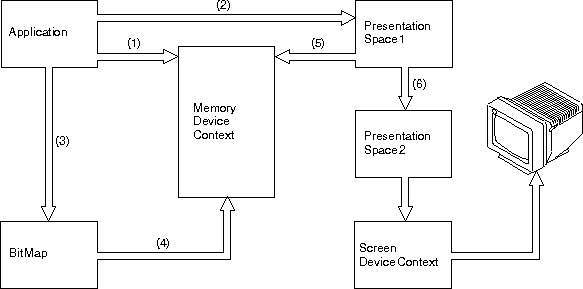By an Application
To enable an application to create a bit map:
- Create a memory device context.
A memory device context enables an application to treat a bit map in memory
as though it were a device. For example, an application can copy color information
from another bit map, or copy pels on the display, into a bit map associated
with a memory device context.
To create the memory device context, call DevOpenDC with:
- A device type of OD_MEMORY (second argument)
- A handle to a compatible device context (such as
the device context of a device with which the bit map is to be compatible).
Note: The device device-context handle ideally should be the handle
of the actual device to which you will be directing the bit map. Otherwise,
it will be necessary to change ownership to the appropriate device driver
before the BitBlt operation (which copies the bit map from one presentation
space to one associated with a screen device context). As a consequence,
the image may appear distorted.
If you omit the
handle of the compatible device context by specifying NULL, screen compatibility
is assumed.
2.
Create a graphics
presentation space and associate it with the memory device context.
The operating system requires this association before the application can
perform many of the bit map operations. The handle of this graphics presentation
space is required as input to subsequent bit-map-creation and manipulation
functions.
3.
Create the
bit map.
When an application creates a bit map, the handle of the presentation space
that you have associated with the memory device context causes the bit map
to be created in a format that is compatible with the memory device context.
The application also passes two structures: the bit-map information header
and the bit-map information table. These structures contain a
great deal of information about the bit map.
To create the bit map, call GpiCreateBitmap
with:
- The handle of the presentation space (first argument)
- The bit-map information header, BITMAPINFOHEADER
(second argument). (last argument).
The bit-map
information table contains similar information, with the addition of the
RGB2 array structure.
GpiCreateBitmap returns a handle
to the bit map, which is used to identify the bit map.
To determine which bit-map formats are supported on a particular device,
call GpiQueryDeviceBitmapFormats.
This returns every format supported on a named device. The data is returned
as an array of bit-map plane and bit-count pairs. The first pair of values
in the array is the one most suitable for the device.
You can think of the bit map at this stage as a rectangular area of memory
containing random data. You can initialize the bit map at this stage by
providing GpiCreateBitmap with
the address in application storage of some initialization data and by setting
the CBM_INIT option. This is a useful function if, for example, your application
always starts by displaying the same image.
4.
Select
the bit map.
Before selecting the bit map, you can disassociate the presentation space
from the original memory device context and associate it with a different
memory device context. However, the bit-map format must be convertible to
a format that is supported by the new device. If you have selected one of
the four standard bit-map formats, this compatibility is guaranteed and
the conversion is automatic.
Note: When a presentation space is associated with a memory device
context, a bit map must be selected into the device context before you can
draw in the presentation space.
To select the bit map, call GpiSetBitmap
with:
- The presentation-space handle (first parameter)
- The bit-map handle (second parameter).
The following figure shows the sequence of events when you create and display
a bit map.
Creating and Displaying Bit Maps
The application:
